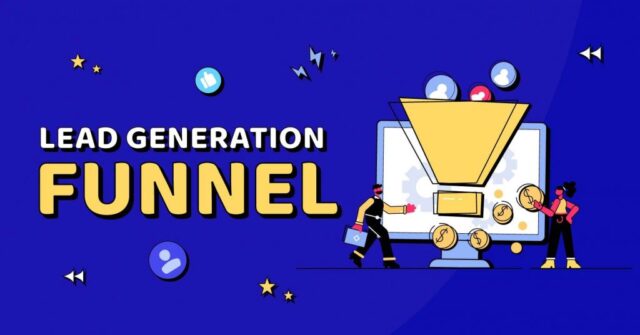In the digital marketing landscape, a lead generation funnel is an essential component for attracting potential customers and guiding them through the buying journey. A well-structured funnel not only helps you capture leads but also nurtures them until they convert into paying customers. In this blog post, we’ll explore the steps to create an effective lead generation funnel that drives results for your business.

Table of Contents
ToggleWhat is a Lead Generation Funnel?
A lead generation funnel is a strategic framework that outlines the journey potential customers take from the moment they first become aware of your brand to when they make a purchase. The funnel typically consists of several stages: Awareness, Interest, Decision, and Action (AIDA model). Understanding each stage is crucial for optimizing your lead generation efforts.
The Stages of a Lead Generation Funnel
- Awareness: At this stage, potential customers discover your brand through various channels, such as social media, search engines, or content marketing. The goal is to capture their attention and make them aware of your products or services.
- Interest: Once potential customers are aware of your brand, you need to pique their interest. This can be done by providing valuable content, engaging with them through email marketing, or offering a lead magnet, such as an e-book or webinar.
- Decision: In this stage, leads are evaluating their options and considering whether to purchase from you. Provide detailed information about your products, customer testimonials, case studies, and comparison guides to help them make informed decisions.
- Action: Finally, encourage leads to take action, such as making a purchase, signing up for a trial, or scheduling a consultation. This is where your sales efforts come into play.
Steps to Create an Effective Lead Generation Funnel
1. Define Your Target Audience
Before creating your lead generation funnel, it’s essential to understand your target audience. Create detailed buyer personas that outline their demographics, interests, pain points, and motivations. This will help you tailor your content and messaging to resonate with your ideal customers.
2. Develop Compelling Content
Content is the backbone of your lead generation funnel. Create valuable, relevant, and engaging content that addresses your audience’s needs and interests. This can include:
- Blog Posts: Share informative articles that provide solutions to your audience’s problems.
- E-books and Whitepapers: Offer in-depth resources that require users to provide their contact information to download.
- Webinars: Host live sessions that allow you to share your expertise and engage with your audience in real time.
3. Create Lead Magnets
A lead magnet is a valuable resource you offer in exchange for a prospect’s contact information. This could be an e-book, checklist, template, or free trial. The key is to ensure that your lead magnet provides genuine value to your audience, compelling them to share their information.
4. Design Landing Pages
Landing pages are crucial for converting visitors into leads. Create dedicated landing pages for each lead magnet or offer, focusing on a clear call-to-action (CTA). Ensure your landing page includes:
- Compelling Headlines: Grab attention with a strong, benefit-driven headline.
- Concise Copy: Clearly explain the value of your offer and how it addresses your audience’s pain points.
- Simple Forms: Minimize friction by keeping your forms short and asking for only essential information.
5. Implement a Lead Capture System
Integrate a lead capture system, such as email marketing software or a Customer Relationship Management (CRM) tool, to collect and manage leads. This system will help you track leads, segment your audience, and nurture them through the funnel.
6. Nurture Your Leads
Not all leads will convert immediately. Implement a lead nurturing strategy to guide prospects through the funnel. This can include:
- Email Marketing: Send targeted email campaigns with personalized content, product updates, and exclusive offers.
- Retargeting Ads: Use retargeting ads to re-engage visitors who didn’t convert on their first visit to your website.
- Follow-up Calls: For high-value leads, consider follow-up calls to address any questions and encourage conversion.
7. Optimize for Conversion
Continuously analyze and optimize your lead generation funnel for better performance. Monitor key metrics, such as conversion rates, click-through rates, and lead quality. Use A/B testing to experiment with different content formats, landing page designs, and CTAs to see what resonates best with your audience.
8. Evaluate and Adjust Your Strategy
Regularly assess the effectiveness of your lead generation funnel. Collect feedback from leads and customers to identify areas for improvement. Stay informed about industry trends and adapt your strategy to meet the changing needs of your audience.
Conclusion
Creating an effective lead generation funnel is a powerful way to attract, engage, and convert potential customers. By understanding your audience, providing valuable content, and nurturing leads through the buying journey, you can build a robust pipeline that drives business growth. Remember, the key to success lies in continuous optimization and adaptation to your audience’s needs. Start building your lead generation funnel today, and watch your conversion rates soar!


No responses yet